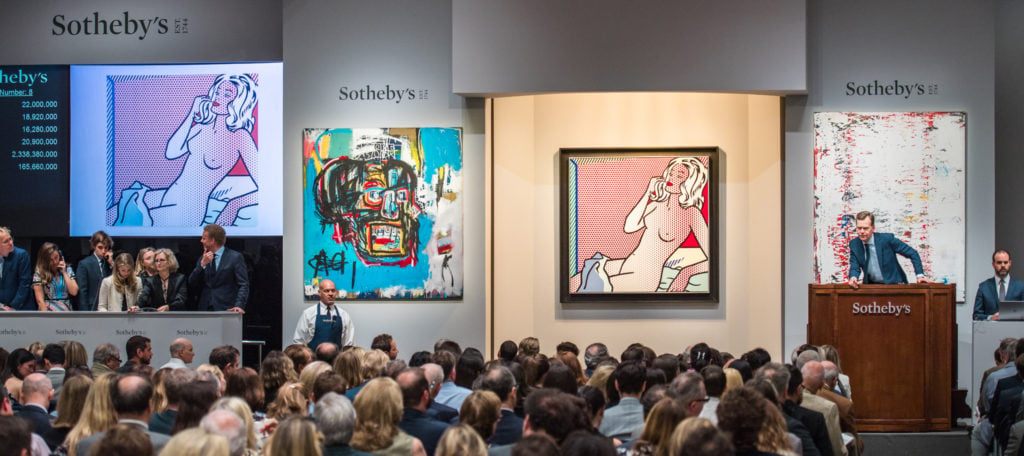Auctions
Sotheby’s Boosts Private Sales But Loses Ground on Auctions in First Half of 2017
The auction house also saw a 26% increase in American buying.

The auction house also saw a 26% increase in American buying.

Sotheby’s made headlines last week when its share price hit a record high. Was the strong stock-market performance an indication of booming business? Not quite, according to the company’s results for the first six months of 2017, which were released this morning.
The aggregate auction sales at Sotheby’s actually decreased by two percent compared to the same period a year ago. The total, calculated in dollars and including the buyers’ premium, came in at $2.41 billion.
Sotheby’s notes that the auction total does not offer a full picture. During the same period, private sales increased by 34 percent, to $333.8 million—almost back to 2015 levels and, interestingly, double Christie’s lackluster private sales total released last month. Sotheby’s also increased sales from inventory from $12 million to $91 million (this covers stock they guaranteed but did not sell the first time around, like lots from the Alfred Taubman collection).
Combining all three sources of income, Sotheby’s consolidated sales total for the first six months of the year is $2.83 billion—up 4 percent on last year and just a fraction behind Christie’s equivalent result of $3 billion.
Both houses saw an increase in high-end sales, although they defined “high-end” differently. Christie’s highlighted 38 lots that sold for over £10 million, while Sotheby’s noted a 16 percent increase in $3 million-plus sales, to 106 lots. What was pleasing here, executives said, was that their commission margins, which normally go down as the price goes up, did not decrease.
On an earnings call this morning, Sotheby’s CEO Tad Smith described the performance as “solid”—an optimistic euphemism in the art market for safe but unspectacular.
Contemporary art continued its domination of market share. Sotheby’s saw a 37 percent improvement in contemporary art sales, to $701.4 million, as might have been expected after the $98 million hammer price for Jean-Michel Basquiat’s Untitled canvas at its May auctions in New York. (Sotheby’s provides only hammer totals for net sales in the specific sectors of the business, but overall totals include the buyer’s premium.) Still, the contemporary total only represents a $30 million increase on 2015.
Another sector on the rise was Impressionist and Modern art, which was up by 23 percent, to $594 million—though this department still has a way to go to meet the 2015 total of $926.8 million.
Old Master paintings and drawings had a less successful six months, with a total of $49.5 million, down by 48 percent compared to the equivalent period last year. (Judging by the successful London sales in July, however, that descent will not last.)
There was also a 32 percent decrease in Asian art sales, to $255.5 million, down also from 2015’s equivalent total of $327 million. Sotheby’s also experienced a surprising 19 percent decrease in luxury items, jewelry, wine, and watches. (This $250.3 total does not include the $71 million pink diamond sold in April, which has not yet been fully paid for.)
As at Christie’s, Americans were the fastest-growing sector of buyers, up by 26 percent. European buying was up 18 percent; Asia, only three percent.
Much was made of Sotheby’s progress in the digital sphere, with 81% of online-only offerings finding buyers. (No sales totals were made available, so it is difficult to know how many high-value works are being sold in online-only sales.)
Sotheby’s is clearly investing in marketing tools like video and magazine content, and executives are studying the effect they have on buyers. Already, clients can receive digital recommendations for purchases, thanks in part to technology that determines a client’s tastes and needs based on previous activity. The day of the robot at Sotheby’s may soon be at hand.
The house also reported progress on its representation of artists and estates, although no names were forthcoming. Similarly, the number of clients introduced to the auction house by Art Agency Partners, the in-house art advisory run by Amy Cappellazzo and Allan Schwartzman, was said to have increased by 20 percent since 2016, but the house did not offer figures to clarify exactly how many new clients have come aboard.
Overall, the new statistics did not add up to a major boom in progress. The high stock market prices last week were achieved amid the general momentum of the wider market, and this report did nothing to energize them. By mid-afternoon, Sotheby’s share price was down four points from the day’s $54.71 morning high.